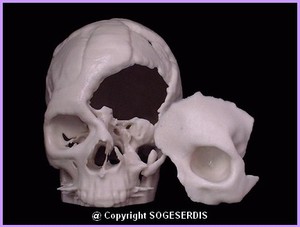Applications
![]()
Traditional pre-surgical planning is based on the manipulation of 2D data obtained by traditional radiography. However, this technique limits the full appreciation of bone structure movements. Surgeons must mentally visualize the section of the body being examined as well as the pathology.
With 3D imaging, visualization in coronal, axial and sagittal view facilitates the analysis of the section being examined as well as communication with patients, prosthesis design and simulation of surgical procedures.
3D models can be sawed apart and realigned for proper anatomical fit of pre-contoured implants. They can be drilled and threaded. Osteosynthesis plates can be shaped on the prototype and fixed by screws for surgery rehearsal.
![]()
When a patient’s skull has a defect that crosses the skull’s midline, mirroring reconstruction becomes impossible and makes the design of the prosthesis very difficult.
However, the 3D reconstruction softwares we use make it possible to fill holes on regions where there are defects, thus facilitating the design of trial custom prostheses.
The prosthesis design process consists of two steps:
STEP 1: 3D reconstruction of the skull from a CT scan

STEP 2: Design of the trial prosthesis after filling the region where there was a defect

![]()
Rapid prototyping can also be combined with colour medical modelling. This technique is a bone density colour matching method applied to the prototype which gives surgeons the opportunity to determine exactly where there is adequate bone volume to place implants, screws or prostheses safely.

![]()
3D models permit perfect communication between surgeons and surgical teams but also pre-surgical planning through rehearsal of operations such as implant pre-contouring (screw and instrument selection, screw trajectory and location). 3D models also enhance communication, understanding and confidence between surgeons and patients.
![]()
3D models allow enhanced communication between surgeons and students. They prove very useful in preparing pedagogic and interactive exhibitions or classes and allow better understanding of the anatomy, pathologies and surgical procedures.

Using prototypes for pre-surgical planning also reduces operating room time, lowers cost, and enhances patient outcomes by minimizing incision sizes and reducing recovery time.


/https%3A%2F%2Fstorage.canalblog.com%2F60%2F14%2F369388%2F20925925_o.jpg)
/https%3A%2F%2Fstorage.canalblog.com%2F32%2F70%2F369388%2F19547568_o.jpg)


/https%3A%2F%2Fstorage.canalblog.com%2F02%2F19%2F369388%2F19113363_o.jpg)
/https%3A%2F%2Fstorage.canalblog.com%2F79%2F63%2F369388%2F19144505_o.jpg)
/https%3A%2F%2Fassets.over-blog.com%2Ft%2Fcedistic%2Fcamera.png)